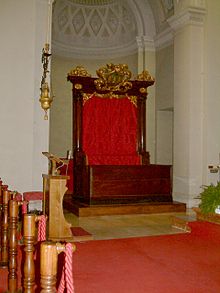Captains Regent
| Captains Regent of San Marino | |
|---|---|
| Capitani Reggenti di San Marino | |
 | |
| Style | The Most Excellent |
| Type | Head of state |
| Seat | Palazzo Pubblico |
| Appointer | Grand and General Council Two-round system |
| Term length | 6 months, reeligible after 3-year respite |
| Constituting instrument | Constitution of San Marino Declaration on the Rights of the Citizens |
| Formation | 13th century |
| Salary | €6,000 per month[1] |
Captains Regent (Italian: Capitani Reggenti) are the two heads of state of the Republic of San Marino. They are elected every six months by the Grand and General Council, the country's legislative body. Normally the Regents are chosen from parties in coalition and serve a six-month term. The investiture of the Captains Regent takes place on 1 April and 1 October every year. This tradition dates back at least to 1243.[2]
The practice of dual heads of government (diarchy) is derived directly from the customs of the Roman Republic, equivalent to the consuls of ancient Rome. The Captains Regent are not heads of government, but only heads of state without executive power.
History[edit]

The establishment of the regency took place during the first half of the 13th century, when they had the role of managing justice, a task similar to the competence of magistrates.[citation needed] During that period they were called consuls, which derived from ancient Rome.[citation needed] The first two known consuls were elected on 12 December 1243 by the Grand and General Council with a six-month term which is still used today.[citation needed]
At the end of the 13th century, the name of the institution started to change, as one took the title of "captain" and the other one of "defender", then in 1317 they became captain and rector.[citation needed] One usually belonged to the upper class, to guarantee the possession of skills necessary to govern the Republic with competence, and one to the working class.[citation needed]
In 1972, a law was passed to abolish all the restrictions which prevented women from taking public positions. A woman, Maria Lea Pedini-Angelini, was elected Captain Regent for the first time on 1 April 1981.[3] On 1 April 2017, for the first time two women, Vanessa D'Ambrosio and Mimma Zavoli, concurrently occupied the posts of Captains Regent, until their term ended on 1 October 2017.
As of 1 April 2020, after electing its 18th female Captain Regent, San Marino is the country with the most female heads of state in the world (however, many other countries have had a female head of state for longer than the combined 10.5 years of these 18 Captains Regent).

Election[edit]
 |
|---|
The Captains Regent are elected every six months by the Grand and General Council, and they usually belong to opposite parties to grant a minimal amount of balance and an equal supervision. The electoral procedure is disciplined by a 1945 law, which is mainly based on the Leges Statutae Republicae Sancti Marini of 1600.[4]
The pair is elected if it achieves an absolute majority; there is a second ballot if no pair gets enough votes.
Eligibility[edit]
To be eligible for election the candidate should have the following requirements:
- Citizenship from birth (jus sanguinis)
- Be at least 25 years old
- Be an elected deputy of the Grand and General Council
- Not have been elected Captain Regent in the last three years
Investiture[edit]
The investiture ceremony takes place on 1 April and 1 October every year, and is described by Leges Statutae Republicae Sancti Marini. In the morning, in the Piazza della Libertà, the Sammarinese Armed Forces are assembled and the flag-raising ceremony takes place. The newly elected Captains Regent then proceed from the Palazzo Pubblico to the Basilica of San Marino where a High Mass is celebrated by the Bishop of San Marino in celebration of their assumption of office. The entourage returns to the Palazzo, where the official address is made and the elected Captains Regent are sworn in according to the oath describes in the Statutes of 1600. The outgoing Captains Regent place the collar of the Order of San Marino on the new Captains Regent, finalizing the transfer of power. The swearing in ends as the band plays the National Anthem and the outgoing Captains Regent afterward take their leave. The Procession then heads to Palazzo Valloni for the assumption of the Captain's Throne and the residency.
Finally, the Armed Forces assemble once more for a flag lowering ceremony.[5]
Power[edit]
The Regency is considered the supreme office of the Republic. The Captains Regent are the head of state, a function which they carry out as a single body, with a reciprocal right of veto. They have the right to be addressed with the honorific title of Excellency.
The Captains Regent are impartial and their power is mainly symbolic, as their main duty is to represent the country and to guarantee the constitutional order. They supervise the Grand and General Council, the Congress of State and the Council of XII, but without any right to vote or to decide. They dissolve the parliament when the legislature is over or when it is unable to form a stable government. The Captains Regent also have the power to promulgate and order the publication of the laws approved by the Grand and General Council.
Regency Syndicate[edit]
The Captains Regent cannot be prosecuted in any way during their mandate, at the end of which they are subject to the Regency Syndicate. This judgement, established by the Statutes of 1499, is now fulfilled by the Guarantors' Panel on the Constitutionality of Rules, following the revision of the Declaration on the Citizens' Rights. The procedure provides that, within fifteen days after the conclusion of their mandate, every citizen registered in the electoral lists may submit claims against the Captains Regent "for what they have and have not done" during their mandate.
See also[edit]
References[edit]
- ^ Galullo, Roberto (8 November 2012). "A San Marino un candidato ogni 88 residenti. Il parlamentare guadagna mille euro al mese" [In San Marino one candidate for every 88 residents. The parliamentarian earns a thousand euros a month]. Il Sole 24 ORE (in Italian).
- ^ "Captains Regent — Repubblica di San Marino, portale ufficiale". Retrieved 31 January 2016.
- ^ "Women Captains Regent". Retrieved 31 January 2016.
- ^ "Election of the Captains Regent". Retrieved 31 January 2016.
- ^ "Investiture Ceremony of the Captains Regent - Ufficio di Stato per il Turismo". archivio.visitsanmarino.com. Retrieved 28 September 2022.

